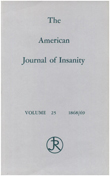Reversal of asymmetry of the planum temporale in schizophrenia
Abstract
OBJECTIVE: The planum temporale is intimately involved in the generation and understanding of language and has been suggested to be a key area affected in schizophrenia. To explore temporal lobe abnormalities in schizophrenia, the authors measured the planum temporale, a normally asymmetric area lying on the superior part of the temporal lobe, in schizophrenic patients. METHOD: High-resolution magnetic resonance imaging (MRI) scans were obtained for 14 right- handed schizophrenic patients and 14 healthy comparison subjects individually matched for age, sex, handedness, race, and parental socioeconomic status. The surface area of the planum temporale was measured by using MRI reconstruction techniques. RESULTS: There was striking reversal of the normal asymmetry (left larger than right) in planum temporale surface area in 13 of the schizophrenic patients but in only two of the comparison subjects. However, Heschl's gyrus (primary sensory cortex), which served as an anatomically contiguous nonheteromodal cortical comparison region, showed no difference between the left and right sides in either group. Severity of thought disorder in the patients was related to asymmetry. CONCLUSIONS: This is a clear demonstration of a reversal of expected symmetry in the brains of right- handed schizophrenic patients, which involves a region of key importance in normal human behavior. The nature of the abnormality strongly suggests that schizophrenia is a neurodevelopmental disorder.
Access content
To read the fulltext, please use one of the options below to sign in or purchase access.- Personal login
- Institutional Login
- Sign in via OpenAthens
- Register for access
-
Please login/register if you wish to pair your device and check access availability.
Not a subscriber?
PsychiatryOnline subscription options offer access to the DSM-5 library, books, journals, CME, and patient resources. This all-in-one virtual library provides psychiatrists and mental health professionals with key resources for diagnosis, treatment, research, and professional development.
Need more help? PsychiatryOnline Customer Service may be reached by emailing [email protected] or by calling 800-368-5777 (in the U.S.) or 703-907-7322 (outside the U.S.).



